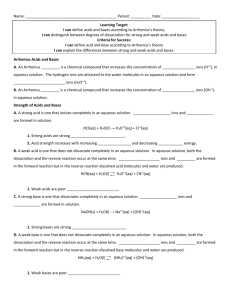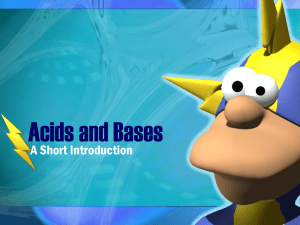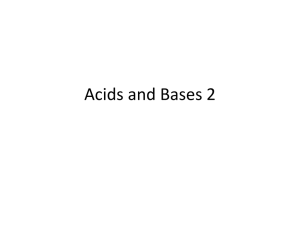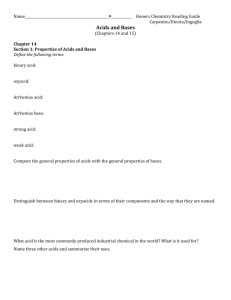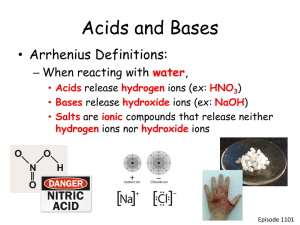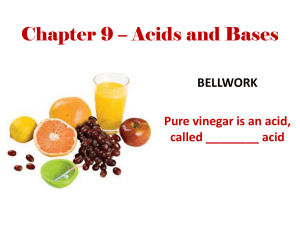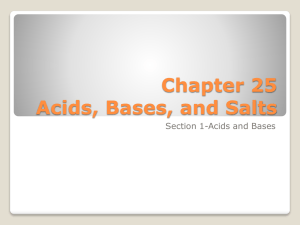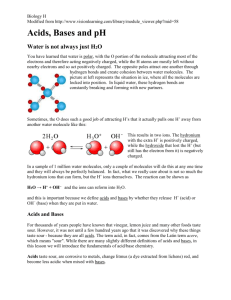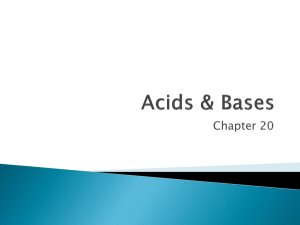Ch. 19 - Acids, Bases and Salts
advertisement
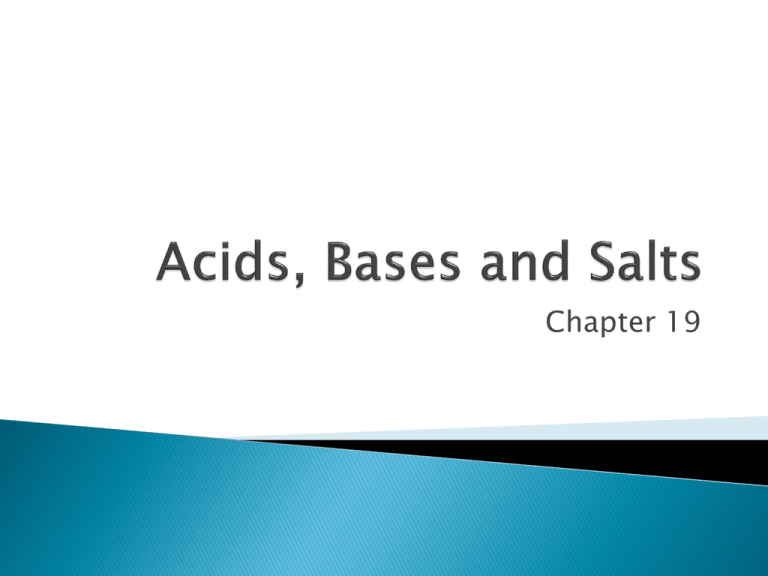
Chapter 19 19.1 Bracken Cave, near San Antonio, Texas, is home to twenty to forty million bats. Visitors to the cave must protect themselves from the dangerous levels of ammonia in the cave. Ammonia is a byproduct of the bats’ urine. You will learn why ammonia is considered a base. 19.1 Properties of Acids and Bases ◦ What are the properties of acids and bases? 19.1 Taste sour Are electrolytes Neutralize bases to form water and a salt React with some metals to produce hydrogen gas Change acid-base indicator colors (ref table M) 19.1 19.1 Citrus fruits contain citric acid. Tea contains tannic acid. 19.1 Taste bitter Feel slippery Are electrolytes Neutralize acids to produce water and a salt Change acid-base indicator colors (ref table M) 19.1 19.1 Antacids use bases to neutralize excess stomach acid. The base calcium hydroxide is a component of mortar. 19.1 Arrhenius Acids and Bases How did Arrhenius define an acid and a base? 19.1 Arrhenius said that acids yield hydrogen ions (H+) as the only positive ion in solution. HCl H+ + Cl- H2SO4 H3PO4 Note: acid formulas start with H 19.1 ◦ A hydrogen ion is a proton. Acids that contain one ionizable hydrogen, such as nitric acid (HNO3), are called monoprotic acids. Acids that contain two ionizable hydrogens, such as sulfuric acid (H2SO4), are called diprotic acids. Acids that contain three ionizable hydrogens, such as phosphoric acid (H3PO4) are called triprotic acids. 19.1 19.1 Arrhenius said that bases yield hydroxide ions (OH–) as the only negative ion in solution. NaOH Na+ + OHCa(OH)2 19.1 Which of the following acids and bases do not fit the definition of an Arrhenius acid or base? ◦ ◦ ◦ ◦ ◦ ◦ NH3 Ca(OH)2 HCl H2SO4 CO2 NaOH 19.1 Brønsted-Lowry Acids and Bases ◦ What distinguishes an acid from a base in the Brønsted-Lowry theory? 19.1 ◦ The Brønsted-Lowry theory defines an acid as a proton donor, and a base as a proton acceptor. 19.1 ◦ Ammonia is a Base Identify the acids and bases in the following equations: NH3 + H2O NH4+ + OH- HCl + H2O H3O+ + Cl- 19.1 Lewis Acids and Bases ◦ How did Lewis define an acid and a base? 19.1 ◦ Lewis proposed that an acid accepts a pair of electrons during a reaction, while a base donates a pair of electrons. 19.1 A Lewis acid is a substance that can accept a pair of electrons to form a covalent bond. A Lewis base is a substance that can donate a pair of electrons to form a covalent bond. 19.2 To test a diagnosis of diabetic coma, a doctor orders several tests, including the acidity of the patient’s blood. Results from this test will be expressed in units of pH. You will learn how the pH scale is used to indicate the acidity of a solution and why the pH scale is used. 19.2 Hydrogen Ions from Water The reaction in which water molecules produce ions is called the self-ionization of water. 19.2 In the self-ionization of water, a proton (hydrogen ion) transfers from one water molecule to another water molecule. 19.2 Ion Product Constant for Water ◦ How are [H+] and [OH-] related in an aqueous solution? 19.2 ◦ For aqueous solutions, the product of the hydrogen-ion concentration and the hydroxide-ion concentration equals 1.0 10-14. ◦ Any aqueous solution in which [H+] and [OH-] are equal is described as a neutral solution. 19.2 The product of the concentrations of the hydrogen ions and hydroxide ions in water is called the ionproduct constant for water (Kw). 19.2 An acidic solution is one in which [H+] is greater than [OH-]. 19.2 Unrefined hydrochloric acid, commonly called muriatic acid, is used to clean stone buildings and swimming pools. 19.2 A basic solution is one in which [H+] is less than [OH]. Basic solutions are also known as alkaline solutions. 19.2 Sodium hydroxide, or lye, is commonly used as a drain cleaner. 19.2 The pH Concept ◦ How is the hydrogen-ion concentration used to classify a solution as neutral, acidic, or basic? 19.2 The pH of a solution is the negative logarithm of the hydrogen-ion concentration. 19.2 Calculating pH 19.2 A solution in which [H+] is greater than 1 10–7 M has a pH less than 7.0 and is acidic. The pH of pure water or a neutral aqueous solution is 7.0. A solution with a pH greater than 7 is basic and has a [H+] of less than 1 10–7 M. 19.2 19.2 19.2 19.2 Measuring pH ◦ What is the most important characteristic of an acid-base indicator? 19.2 ◦ An indicator is a valuable tool for measuring pH because its acid form and base form have different colors in solution. ◦ Reference table M. 19.2 Phenolphthalein changes from colorless to pink at pH 7–9. 19.2 ◦ Acid-Base Indicators 19.2 19.2 Universal Indicators 19.2 ◦ pH Meters 19.3 Lemons and grapefruits have a sour taste because they contain citric acid. Sulfuric acid is a widely used industrial chemical that can quickly cause severe burns if it comes into contact with skin. You will learn why some acids are weak and some acids are strong. 19.3 Strong acids are completely ionized in aqueous solution. Weak acids ionize only slightly in aqueous solution. 19.3 Strong bases dissociate completely into metal ions and hydroxide ions in aqueous solution. NaOH (aq) + H2O (l) ⇆ Na+ (aq) + OH- (aq) Weak bases partially react with water to form the hydroxide ion. 19.3 19.4 Excess hydrochloric acid in the stomach can cause heartburn and a feeling of nausea. Antacids neutralize the stomach acid and relieve the pain of acid indigestion. You will learn what a neutralization reaction is. 19.4 Acid-Base Reactions ◦ What are the products of the reaction of an acid with a base? 19.4 In general, the reaction of an acid with a base produces water and a salt. These double replacement reactions are called neutralization reactions. 19.4 19.4 Titration ◦ What is the endpoint of a titration? 19.4 The process of adding a known amount of solution of known concentration to determine the concentration of another solution is called titration. The point of neutralization is the end point of the titration. 19.4 When an acid and base are mixed, the equivalence point is when the number of moles of hydrogen ions equals the number of moles of hydroxide ions. 19.4 The solution of known concentration is called the standard solution. Indicators are often used to determine when enough of the standard solution has been added to neutralize the acid or base. The point at which the indicator changes color is the end point of the titration. 19.4 Acid solution with indicator Added base is measured with a buret. Color change shows neutralization. 19.4 19.5 The chemical processes inside a living cell are very sensitive to pH. Human blood is normally maintained at a pH very close to 7.4. You will learn about chemical processes that ensure that the pH of blood is kept near 7.4. 19.5 Salt Hydrolysis ◦ When is the solution of a salt acidic or basic? 19.5 ◦ In general, salts that produce acidic solutions contain positive ions that release protons to water. Salts that produce basic solutions contain negative ions that attract protons from water. 19.5 In salt hydrolysis, the cations or anions of a dissociated salt remove hydrogen ions from or donate hydrogen ions to water. 19.5 To determine whether a salt solution is acidic or basic, remember the following rules:


